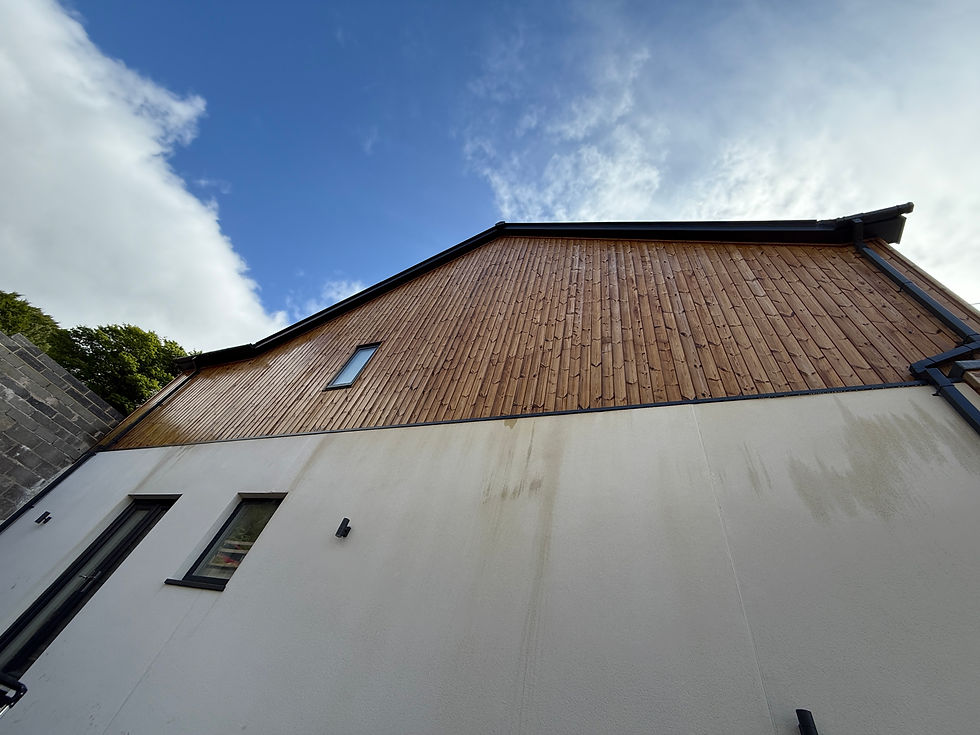Fire Retardant Treatment for Timber Cladding
- Adam Sawyer

- Sep 7, 2022
- 3 min read
Updated: May 25
Timber cladding offers a timeless and natural aesthetic, but untreated wood presents a significant fire risk. At Fire Proofing Ltd, we help contractors, developers, and building owners meet fire safety obligations by applying expert fire retardant treatments that bring timber up to BS EN 13501-1 Class B-s2, d0 standards — the most common requirement for low- to mid-rise UK buildings.
Why Timber Cladding Must Be Fire Treated
Untreated timber typically holds a Euroclass D rating, which is not sufficient under modern regulations. When professionally treated, it can be upgraded to Euroclass B-s2, d0, offering significantly reduced flame spread and enhanced protection.
✅ This is often a requirement for Building Control, planning permission, or fire risk assessments — especially in multi-use or closely built environments.

Fire Regulations by Building Type and Height
Buildings Over 18 Metres
🚫 Combustible materials, including timber, are banned from external walls of residential, institutional, or multi-occupancy buildings over 18 metres. Only non-combustible materials rated A1 or A2-s1,d0 are allowed.
Buildings Under 18 Metres
🟢 Timber cladding can be used, but may need to meet BS EN 13501-1 Class B based on the fire strategy and building type.
Regulations for Smaller Residential Buildings Near Boundaries
For homes or dwellings under 11 metres high, requirements depend on the distance to the property boundary:
Less than 1 metre from boundary: Must meet Class B-s3, d2 or better
1 metre or more from boundary: No fire rating is required, though treatment is still highly recommended
✅ This ensures safety where flame spread could threaten neighbouring structures.
Can Timber Be Treated to Meet Class B?
Yes. Most timber products can be upgraded to Euroclass B through our treatment services, whether:
Raw or unfinished
Previously painted or stained
Installed internally or externally
Our Fire Retardant Treatment Process
Bare Timber
Fire retardant is applied at the required rate per m²
All exposed surfaces must be treated
If finishing after treatment, the product used (paint or varnish) must also be fire-rated
Painted or Stained Timber
Thorough surface cleaning for proper adhesion
Application of adhesion primer
Two coats of fire retardant clear lacquer or paint
Optional decorative topcoat (matt, satin, or gloss)
What is a BS EN 13501-1 Class B Certificate?
A BS EN 13501-1 Class B certificate is issued by an independent lab to confirm that timber treated with specific products meets Euroclass B standards. It includes:
Type of wood
Product system used
Euroclass result
Application and maintenance instructions
Fire Retardant Services from Fire Proofing Ltd
🛠️ Our services include:
On-site or off-site fire retardant treatment
Support selecting the right product and system
Compliant documentation for Building Control
Photos or written evidence for planning submissions
Free guidance before, during, and after the project

What We Need to Quote You
📐 To give you an accurate quote, we’ll need:
Type of timber and current condition (raw, painted, stained)
Total area in square metres
Whether both sides or just one side needs treatment
Project location
📝 You can submit this via our Get a Quote form or contact us directly.
Contact Fire Proofing Ltd
Let’s ensure your timber cladding is compliant, safe, and protected. Our team is here to guide you every step of the way.
📞 Phone: 07970 522475
📧 Email: adam@fire-proofing.co.uk
About the Author
Adam Sawyer, founder of Fire Proofing Ltd, brings over 35 years of experience in fire retardant spraying for timber, fabrics, curtains, and upholstery. His expert advice supports developers, schools, architects, and building managers across the UK in achieving safe, BS-compliant environments.
🔗 Visit our About Us & Our Expert page to learn more








Comments